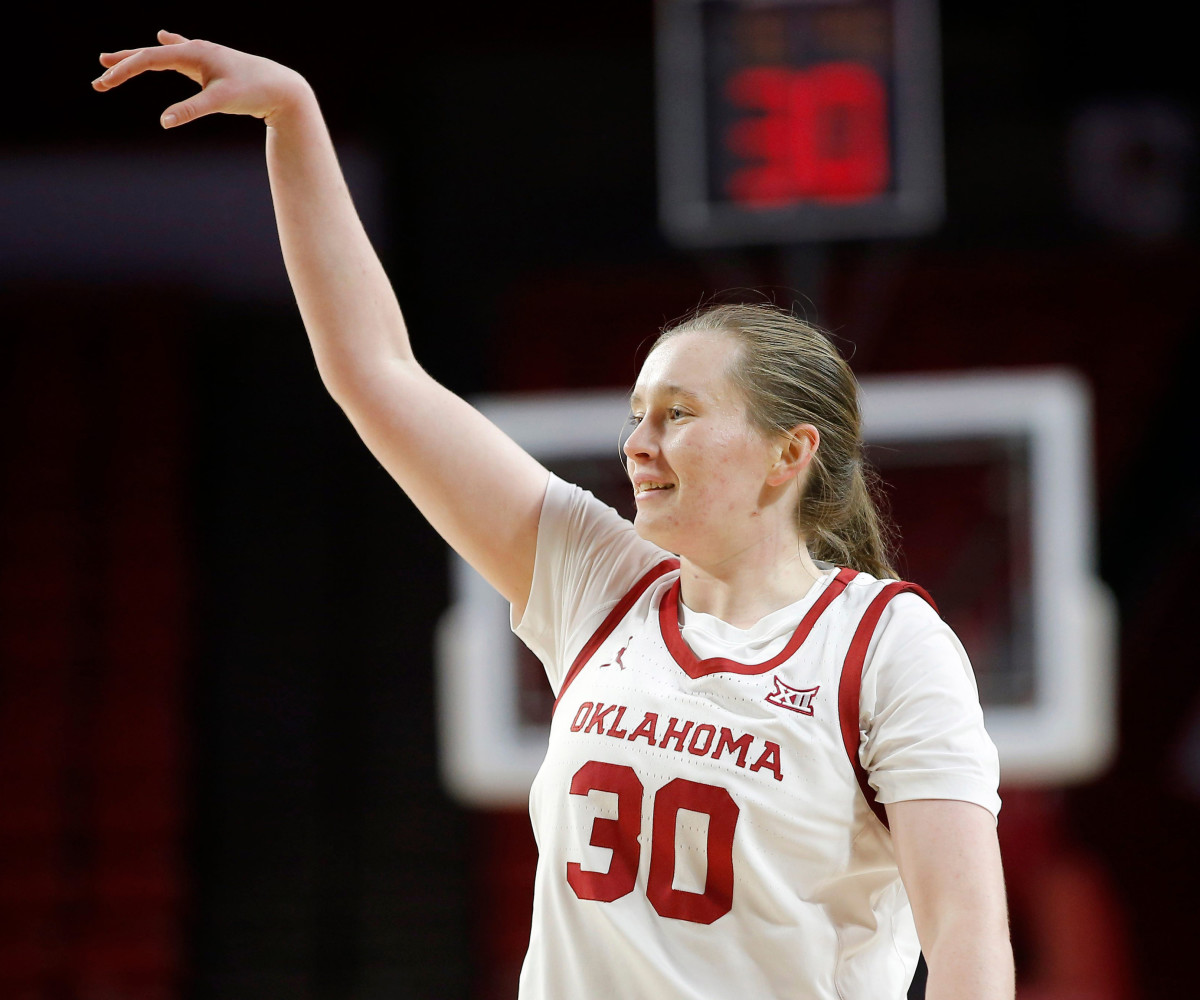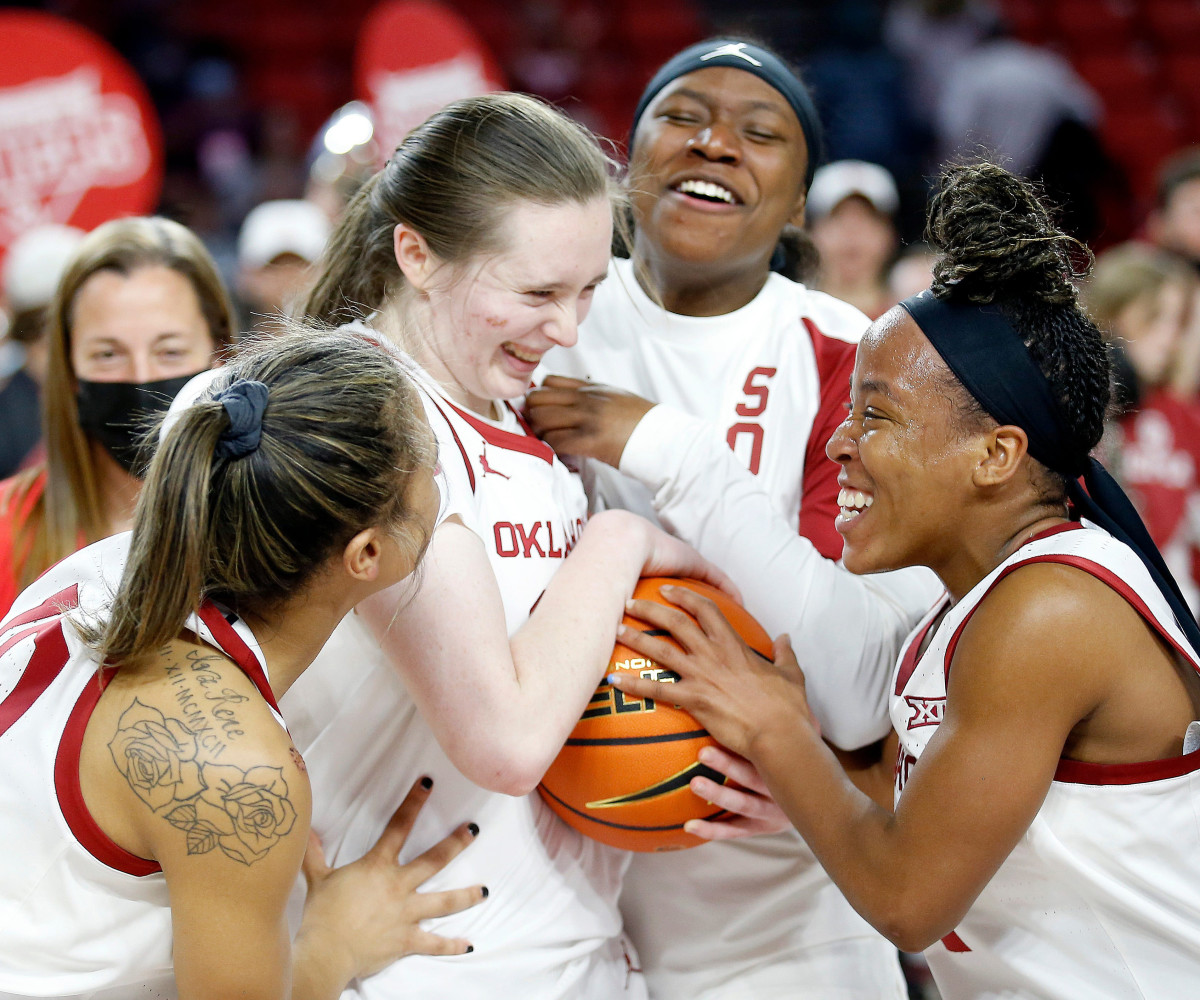Taylor Robertson’s Precision Has the Oklahoma Sharpshooter on the Verge of History
Almost two hours before game warmups begin, Taylor Robertson stands alone on the court. The Oklahoma guard glides across the wood flooring shooting from beyond the arc and then from the free throw line. She goes through ballhandling exercises and game shots. Sometimes a manager rebounds for her. Counting every goal, Robertson stops when her internal tally reaches 230 baskets.
Over the summer, Robertson quantifies how many practice shots from different places on the court should be taken—last season it was 207 warmup shots. Watching the basketball sink into the net repeatedly becomes a meditative process for the redshirt senior. She believes she will score during game time because she’s made the shot countless times before.
“[Many think] she’s a natural shooter,” says her mother, Traci Robertson. “I wouldn’t say that there was a whole lot natural about it. It was hours and hours and hours of time in the gym, time in the driveway. She’s played in thousands of basketball games. It didn’t happen by accident, and I don't know if people really understand how hard she’s worked to get where she is.”

Robertson thrives off rituals. She ate mozzarella sticks every gameday in high school. She returns to the gym around 7 p.m. after practice finishes to continue shooting. That constant structure and dedication is what has the Sooners guard on the verge of history: With 469 career threes, she is just 28 three-pointers away from the NCAA record. Indiana Fever guard Kelsey Mitchell holds the current three-pointers record at 497 from her time at Ohio State. With 19 games left in Oklahoma’s regular season, Robertson is averaging 2.4 three-pointers per game. You do the math.
“Going into the year is exciting knowing that could happen. I try not to focus on it too much because I’m more worried about winning and just trying to do anything to help my team,” Robertson says. “But just knowing that it’s out there and that it would be really cool to be able to do that and doing it with my teammates because they’re just as much a part of it as I am.”
Robertson’s repertoire includes unanimous All-Big 12 first team and holding career three-point records for Oklahoma and the Big 12. The Oklahoma record was set as the Sooners returned from a 19-point deficit to beat Utah. Neither Robertson nor her team realized that she broke the school record until later in the game. When Robertson patented herself as the most prolific three-point shooter in Big 12 history, Oklahoma upset then No. 14 Baylor. Former WNBA player Laurie Koehn held the previous Big 12 record and grew up 15 miles away from Robertson’s hometown in McPherson, Kans. Koehn and Robertson’s grandmothers attended the same church. The local legend challenged Robertson to a competitive game of H-O-R-S-E on the church court. A young Taylor matched Koehn until the professional moved beyond her elementary school shooting range. Years later Robertson received a direct message on Twitter from Koehn congratulating her on beating her record, Koehn telling her she couldn’t be happier for her.
Recognition is always appreciated, but Robertson and her inner circle are indifferent to the accolades. She has a general idea of her career statistics but does not quantify them in comparison to records. The basketball player’s primary concern is the score on the board. Above all else, she wants to win games. This became immediately evident to Sooners coach Jennie Baranczyk when she took over the program in 2021. During their first conversation, Robertson dove into situational questions with her new coach. What would you do with this? What would you do if you were up two? Would you foul here? Baranczyk receives similar questions from Robertson long after practice ends. When she’s not on the court practicing three-pointers, she’s on the couch studying another expert from behind the arc. Robertson rarely misses an NBA game, more specifically a Steph Curry game. She and her coach text back and forth about plays on the TV screen and intense end-game situations. The coach is positive that Robertson could beat anyone in an NBA trivia competition.
“She’s constantly thinking about the game,” Baranczyk says. “She’s one that you would almost have to worry that after practice she’s going down to play pickup with random people somewhere. But you also love that she’s got that sort of game. She just loves to play.”
Before declaring where she would play collegiate basketball, Robertson was open-minded to different programs, but Oklahoma lingered in the back of her head. Her grandfather was a devoted Sooners fan, which seeped down into the following generations. The decision came during Robertson’s junior year of high school, when she was expecting a phone call from former coach Sherri Coale during a tournament week. Before receiving the call she stepped into her father’s hospital room, which blared with music. He was playing the Oklahoma fight song, “Boomer Sooner.” Robertson can still picture the scene in her head.
Her father and coach, Dave Robertson dealt with colon cancer for five years before dying in 2017. The love of basketball and the Sooners bonded them together. Treatment and surgeries couldn’t stop a father from watching his daughter play. Three weeks before the ’12 Elks Hoop National Finals, Robertson’s dad underwent major surgery and spent 10 days in the hospital. The young player had spent the last year in preparation after a disappointing finish the year before—every day she shot 250 to 300 free throws. Dave traveling to the competition in Springfield, Mo., seemed out of the question. Unexpectedly, his doctor cleared him two days before the contest. With her dad cheering her on, Robertson shot a perfect score and won the opportunity to have her name and picture in the Naismith Memorial Basketball Hall of Fame. In her acceptance speech, she dedicated the win to “my favorite rebounder, my dad.”
“The best memory is just all the time we spent in the gym together, because it wasn’t just one time, it was hours and hours,” Robertson says. “The time we got to spend together was the best part.”

Taylor gravitated toward basketball at a young age as she sat on the sidelines while her father coached or her older cousins played. She tried to emulate what she saw on the court. The only thing Taylor wanted from a toy store was a ball. Hours were spent at the YMCA gym with her dad. Form was a priority from the beginning. The basketball was never chucked. Taylor started by trying to hit the net. Once she mastered that, she moved on to the rim and the backboard. She made her first basket at 6 years old. Her fascination for the game bled into every aspect of her life. At school, she would incorporate basketball into art projects and speech presentations. When her younger brother’s nursery was decorated with a Sooners theme, Taylor convinced her parents to do the same to her room. The walls are still painted crimson and cream with basketball posters tacked on in her bedroom back in Kansas.
Baranczyk believes that the records don’t reflect Robertson’s true game. The three-pointers come easily because the tedious gym time has been done for years. Robertson sees two passes ahead and has the desire and ability to expand her game beyond shooting. Besides being an elite scorer from range, Robertson led the team with 104 offensive assists last season. With her intelligence for the game coupled with her prowess and practiced repetitions, Robertson directs the flow of the offense by hitting precise shots or dishing the ball out to her open teammates. She encompasses the perfect offensive threat that uses teammates’ strengths.
It doesn’t matter if it’s a conference game or a matchup of who can get the most steps on a Fitbit, Robertson wants to win. Despite loud crowds, referee whistles and the time clock counting down, her mind quiets when shooting. She can decipher where the basketball will land as soon as it leaves her fingers. Before the ball reaches the net, the team is already running back on defense, much to Baranczyk’s dismay. Robertson’s shot feels automatic.
“She’s self-made, and you can tell she’s worked on it. Her stroke is beautiful. She knows if it’s in or out. She knows if it feels good in her hands,” Baranczyk says. “She knows that because she’s done it so many times. You can even see it in her face before it’s even close to the rim whether that ball’s going in or not.”
